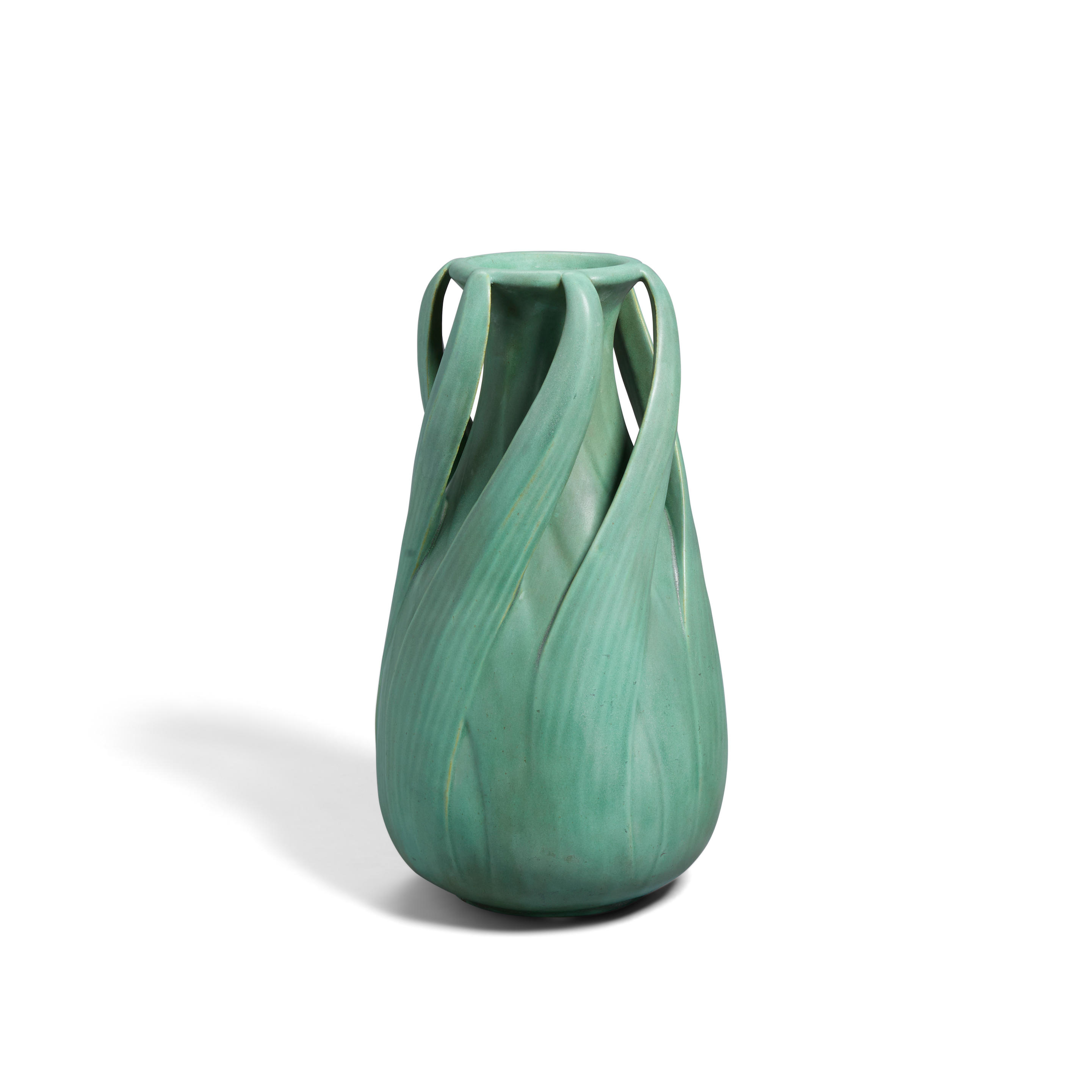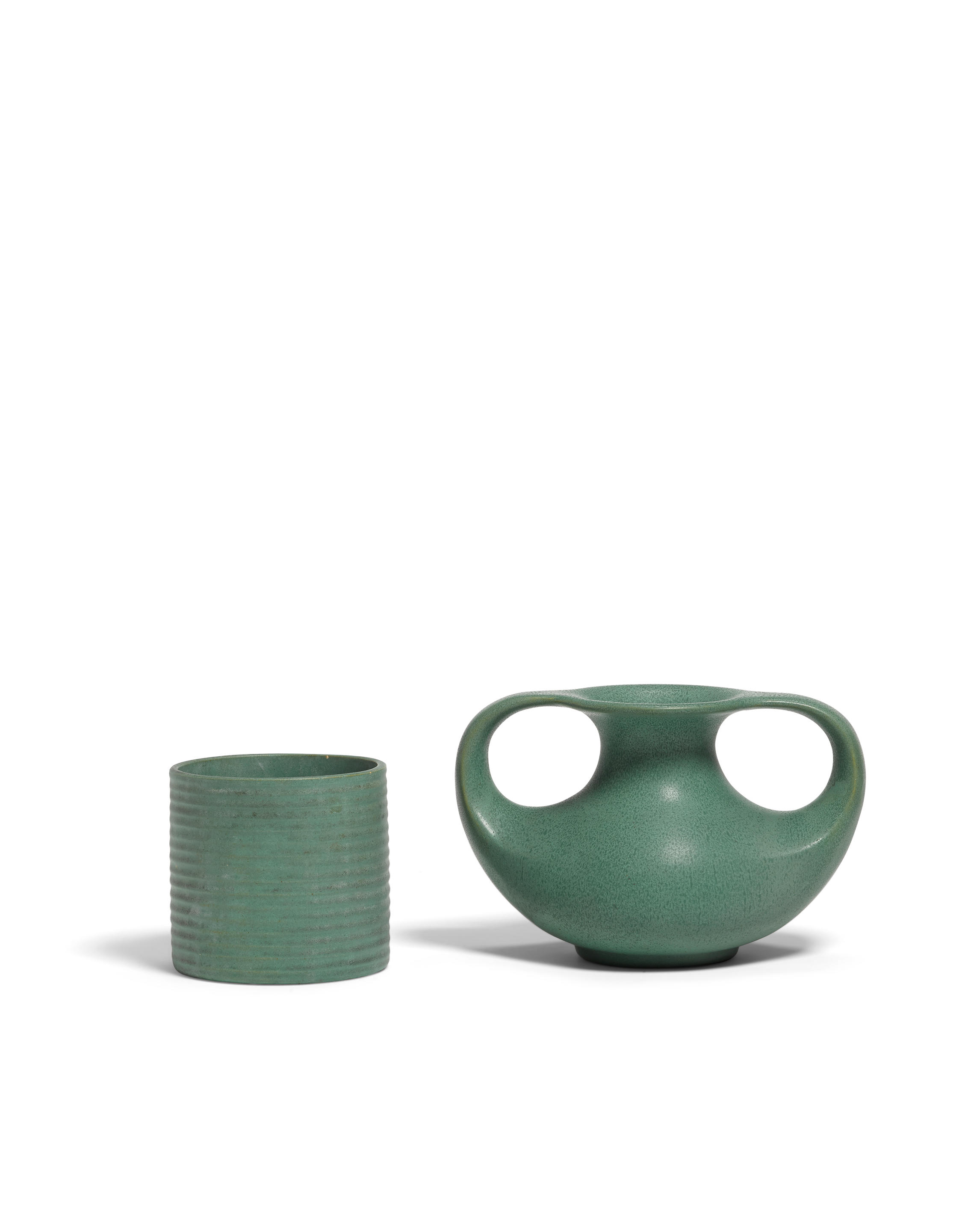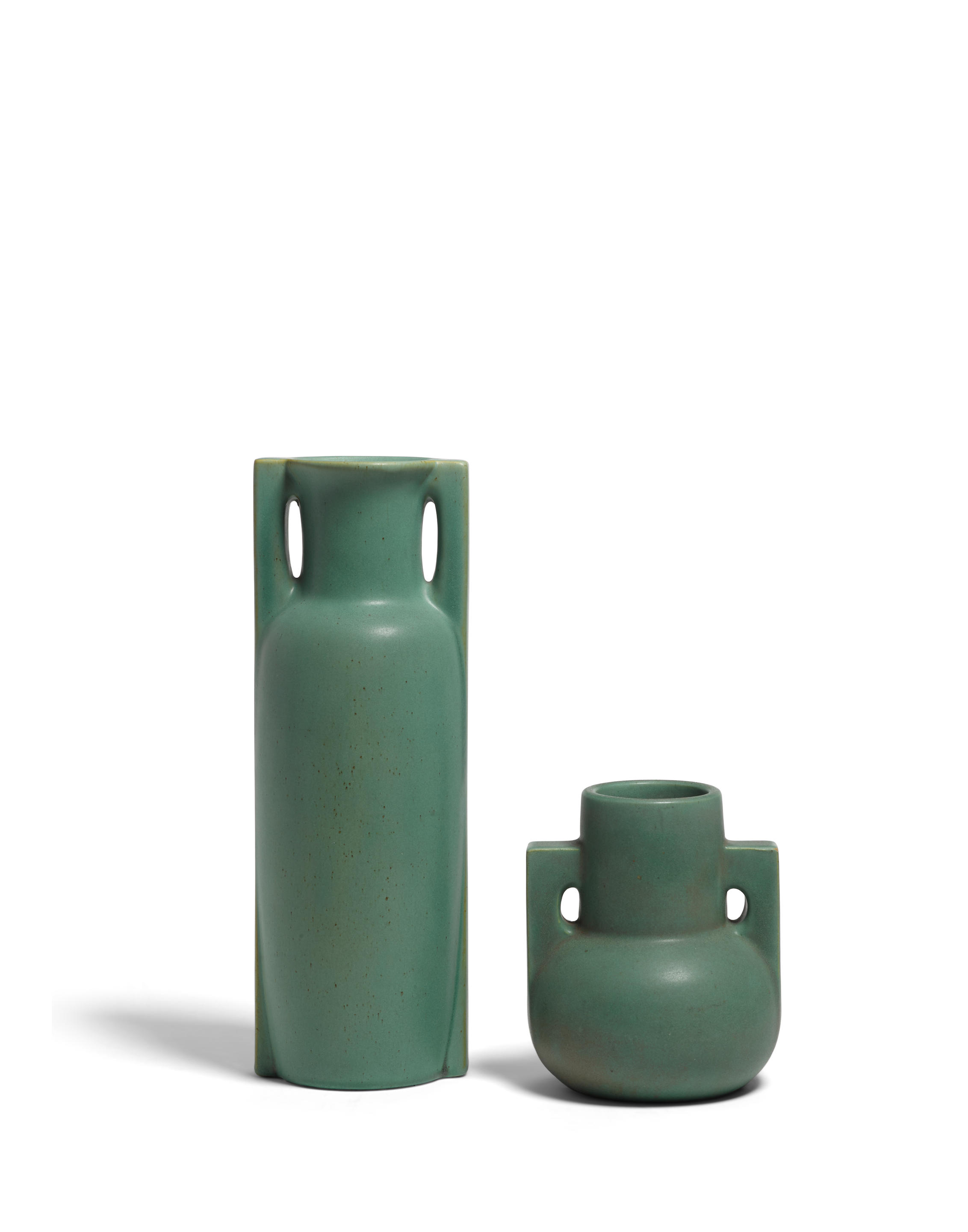Teco Pottery Rare vase with swirling leaves, model no. 310, circa 1905 Designed by Fritz Wilhelm Albert (1865-1940) Glazed earthenware. 18 1/4 in. (46.4 cm) high Produced by The Gates Potteries, The American Terra Cotta & Ceramic Company, Terra Cotta, Illinois, USA. Underside impressed twice with Teco.
Provenance Private collection, New Mexico Literature Teco: Hints for Gifts and Home Decoration, Terra Cotta, IL, 1905, p. 4 Sharon S. Darling, Chicago Ceramics & Glass: An Illustrated History from 1871 to 1933, Chicago, 1979, p. 63, fig. 70 Sharon S. Darling, Teco : Art Pottery of the Prairie School, exh. cat., Erie Art Museum, Erie, PA, 1989, p. 52 for the present model illustrated on the cover of a Teco catalogue, pp. 87, 100, 150 George A. Berry III and Sharon S. Darling, Common Clay: A History of American Terra Cotta Corporation, 1881-1966, Crystal Lake, 2003, p. 10, fig. 18 At Home with Gustav Stickley Arts & Crafts from the Stephen Gray Collection, exh. cat., The Wadsworth Atheneum Museum of Art, Hartford, 2008, p. 96, pl. 87 Judith A. Barter, Apostles of beauty : Arts and Crafts from Britain to Chicago, exh. cat., Art Institute of Chicago, Chicago, 2009, p. 164, fig. 12 Catalogue Essay Following the Great Chicago Fire of 1871, one of the largest disasters of 19th century America which destroyed nearly 18,000 buildings, the demand for fireproof construction techniques ushered in a new phase in architectural design in the Midwest and gave rise to the popularity of decorative brick work made from architectural terra cotta. Among the companies to form during this period was the American Terra Cotta & Ceramic Company, a firm started by lawyer William Gates in a Chicago suburb now known as Terra Cotta, Illinois. By 1900, the “Chicago School” of architects favored terra cotta in its steel-frame constructions, particularly skyscrapers, due to its durability and decorative potential and ATC&C Co. was responsible for fabricating the ornamental terra cotta for many of the Midwest’s most prominent buildings. In addition to architectural brick work, ATC&C Co. produced a line of pottery ware known as Teco (derived from the name Terra Cotta) which was introduced as a way to keep the workmen employed during slow periods of the building trade. While Gates designed many of the pots himself, he also hired and solicited designs from well-known architects and artists to add to the pottery’s repertoire, which by 1904 had won the gold medal at the St. Louis World’s Fair. Among the top designers of Teco’s pottery was Fritz Wilhelm Albert, a Berlin-trained sculptor from Alsace-Lorraine who had come to Chicago in 1893 to work for the German government at the World’s Columbian Exposition. Albert was hired as a modeler for architectural terra cotta in addition to Teco pottery and garden urns and was responsible for much of the pottery’s organic style. His admiration for nature and his training in Europe informed the natural themes and stylized forms of his work and pushed Teco to the foreground of American Arts & Crafts pottery. Setting Teco apart from its ceramic contemporaries, the company used innovative, economical mass-production methods: slip-cast molds which were then sprayed with glaze. The clay used was formulated for low-fire work and as such, Teco pots were not prone to shrinking, cracking or warping from firing – a development which allowed for the designers to create forms not possible with the high-fire clay typically found in decorative ceramics. The slender leaf-like forms winding around the base of the present lot were cut by hand away from a larger clay mold, a technical feat that would have cracked during firing with a different formula. Teco wares were fired using the same industrial processes as the large ornamental bricks, the soft matte glaze a result of the slow firing and cooling process intended for bulk architectural work. The designs of Teco pottery relied on imagery created within the form rather than applied to the form, which gave the designers freedom to produce works of architectonic or organic shape – each reflective of their individual sensibilities. In the case of Fritz Albert, the success of his designs lie in his ability to seamlessly blend industrial process with organic sculptural inspiration – a theme at t
Teco Pottery Rare vase with swirling leaves, model no. 310, circa 1905 Designed by Fritz Wilhelm Albert (1865-1940) Glazed earthenware. 18 1/4 in. (46.4 cm) high Produced by The Gates Potteries, The American Terra Cotta & Ceramic Company, Terra Cotta, Illinois, USA. Underside impressed twice with Teco.
Provenance Private collection, New Mexico Literature Teco: Hints for Gifts and Home Decoration, Terra Cotta, IL, 1905, p. 4 Sharon S. Darling, Chicago Ceramics & Glass: An Illustrated History from 1871 to 1933, Chicago, 1979, p. 63, fig. 70 Sharon S. Darling, Teco : Art Pottery of the Prairie School, exh. cat., Erie Art Museum, Erie, PA, 1989, p. 52 for the present model illustrated on the cover of a Teco catalogue, pp. 87, 100, 150 George A. Berry III and Sharon S. Darling, Common Clay: A History of American Terra Cotta Corporation, 1881-1966, Crystal Lake, 2003, p. 10, fig. 18 At Home with Gustav Stickley Arts & Crafts from the Stephen Gray Collection, exh. cat., The Wadsworth Atheneum Museum of Art, Hartford, 2008, p. 96, pl. 87 Judith A. Barter, Apostles of beauty : Arts and Crafts from Britain to Chicago, exh. cat., Art Institute of Chicago, Chicago, 2009, p. 164, fig. 12 Catalogue Essay Following the Great Chicago Fire of 1871, one of the largest disasters of 19th century America which destroyed nearly 18,000 buildings, the demand for fireproof construction techniques ushered in a new phase in architectural design in the Midwest and gave rise to the popularity of decorative brick work made from architectural terra cotta. Among the companies to form during this period was the American Terra Cotta & Ceramic Company, a firm started by lawyer William Gates in a Chicago suburb now known as Terra Cotta, Illinois. By 1900, the “Chicago School” of architects favored terra cotta in its steel-frame constructions, particularly skyscrapers, due to its durability and decorative potential and ATC&C Co. was responsible for fabricating the ornamental terra cotta for many of the Midwest’s most prominent buildings. In addition to architectural brick work, ATC&C Co. produced a line of pottery ware known as Teco (derived from the name Terra Cotta) which was introduced as a way to keep the workmen employed during slow periods of the building trade. While Gates designed many of the pots himself, he also hired and solicited designs from well-known architects and artists to add to the pottery’s repertoire, which by 1904 had won the gold medal at the St. Louis World’s Fair. Among the top designers of Teco’s pottery was Fritz Wilhelm Albert, a Berlin-trained sculptor from Alsace-Lorraine who had come to Chicago in 1893 to work for the German government at the World’s Columbian Exposition. Albert was hired as a modeler for architectural terra cotta in addition to Teco pottery and garden urns and was responsible for much of the pottery’s organic style. His admiration for nature and his training in Europe informed the natural themes and stylized forms of his work and pushed Teco to the foreground of American Arts & Crafts pottery. Setting Teco apart from its ceramic contemporaries, the company used innovative, economical mass-production methods: slip-cast molds which were then sprayed with glaze. The clay used was formulated for low-fire work and as such, Teco pots were not prone to shrinking, cracking or warping from firing – a development which allowed for the designers to create forms not possible with the high-fire clay typically found in decorative ceramics. The slender leaf-like forms winding around the base of the present lot were cut by hand away from a larger clay mold, a technical feat that would have cracked during firing with a different formula. Teco wares were fired using the same industrial processes as the large ornamental bricks, the soft matte glaze a result of the slow firing and cooling process intended for bulk architectural work. The designs of Teco pottery relied on imagery created within the form rather than applied to the form, which gave the designers freedom to produce works of architectonic or organic shape – each reflective of their individual sensibilities. In the case of Fritz Albert, the success of his designs lie in his ability to seamlessly blend industrial process with organic sculptural inspiration – a theme at t












Testen Sie LotSearch und seine Premium-Features 7 Tage - ohne Kosten!
Lassen Sie sich automatisch über neue Objekte in kommenden Auktionen benachrichtigen.
Suchauftrag anlegen